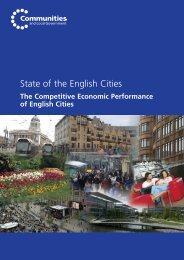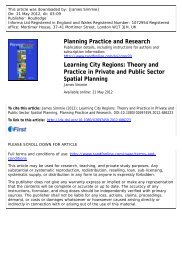History Matters: Path dependence and innovation in British city ...
History Matters: Path dependence and innovation in British city ...
History Matters: Path dependence and innovation in British city ...
You also want an ePaper? Increase the reach of your titles
YUMPU automatically turns print PDFs into web optimized ePapers that Google loves.
Figure 14: Change <strong>in</strong> proportions of employees <strong>in</strong> narrow KIBS <strong>in</strong> selected cities 1981-2005<br />
20<br />
18<br />
16<br />
14<br />
Percentage of<br />
employees<br />
<strong>in</strong> narrow<br />
KIBS<br />
12<br />
10<br />
8<br />
6<br />
4<br />
2<br />
0<br />
1981 1991<br />
2005<br />
Years<br />
Read<strong>in</strong>g Leeds Oxford Aldershot Cambridge<br />
Northampton Warr<strong>in</strong>gton Great Brita<strong>in</strong><br />
Newport<br />
Swansea Wakefield Norwich Middlesbrough<br />
Note: Narrow KIBS <strong>in</strong>cludes the follow<strong>in</strong>g SICs:<br />
72: Comput<strong>in</strong>g <strong>and</strong> related activities<br />
73: Research <strong>and</strong> development<br />
742 + 743: Architectural & eng<strong>in</strong>eer<strong>in</strong>g design activities <strong>and</strong> related technical consultancy; technical test<strong>in</strong>g & analysis<br />
744: Advertis<strong>in</strong>g<br />
7411 + 7412: Legal services; account<strong>in</strong>g, audit<strong>in</strong>g & tax consultancy<br />
7413 + 7414 + 7415: Other KIBS ***<br />
2.5 Local <strong><strong>in</strong>novation</strong> systems are the<br />
dynamic generators of novelty, change<br />
<strong>and</strong> growth <strong>in</strong> their local economies<br />
We def<strong>in</strong>e a local <strong><strong>in</strong>novation</strong> system (LIS)<br />
as “a functionally localised collection of<br />
organisations, <strong>in</strong>stitutions <strong>and</strong> processes<br />
that create or adopt valuable new economic<br />
knowledge <strong>and</strong> commercialise it”. The<br />
generation or adoption of novelty by<br />
comb<strong>in</strong><strong>in</strong>g varieties of <strong>in</strong>digenous with<br />
externally sourced knowledge provides a local<br />
economy with its evolutionary momentum. A<br />
LIS requires the comb<strong>in</strong>ation of <strong>in</strong>digenous<br />
knowledge capacities – <strong>and</strong> knowledge<br />
<strong>in</strong>teraction or collaboration – with the ability<br />
to identify <strong>and</strong> <strong>in</strong>teract or collaborate with<br />
external sources of knowledge to commercialise<br />
<strong>and</strong> export new knowledge.<br />
A local <strong><strong>in</strong>novation</strong> system should <strong>in</strong>ject new<br />
knowledge <strong>and</strong> ideas <strong>in</strong>to the exist<strong>in</strong>g sectors<br />
of a local economy <strong>and</strong> provide the basis<br />
for the emergence of new sub-sectors or<br />
pathways. Such <strong>in</strong>jections may lead to revived<br />
or new economic practices by:<br />
30













